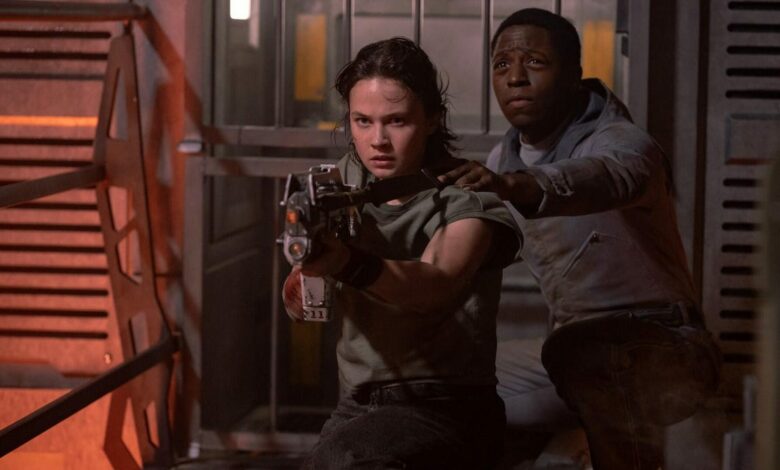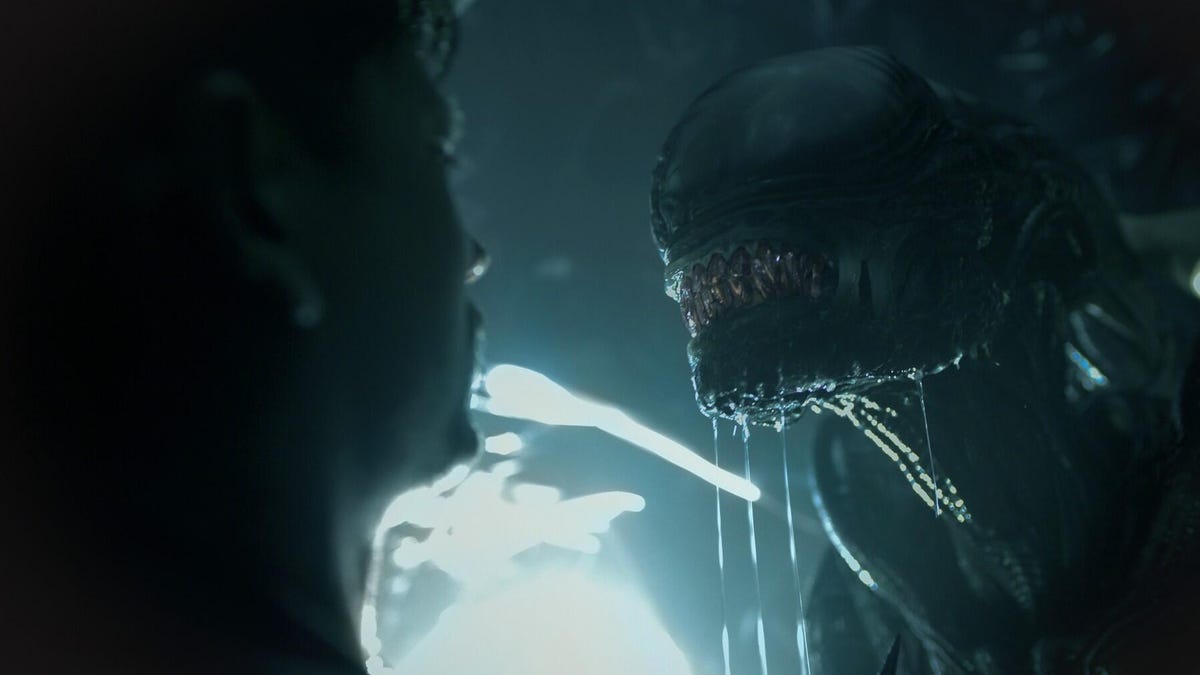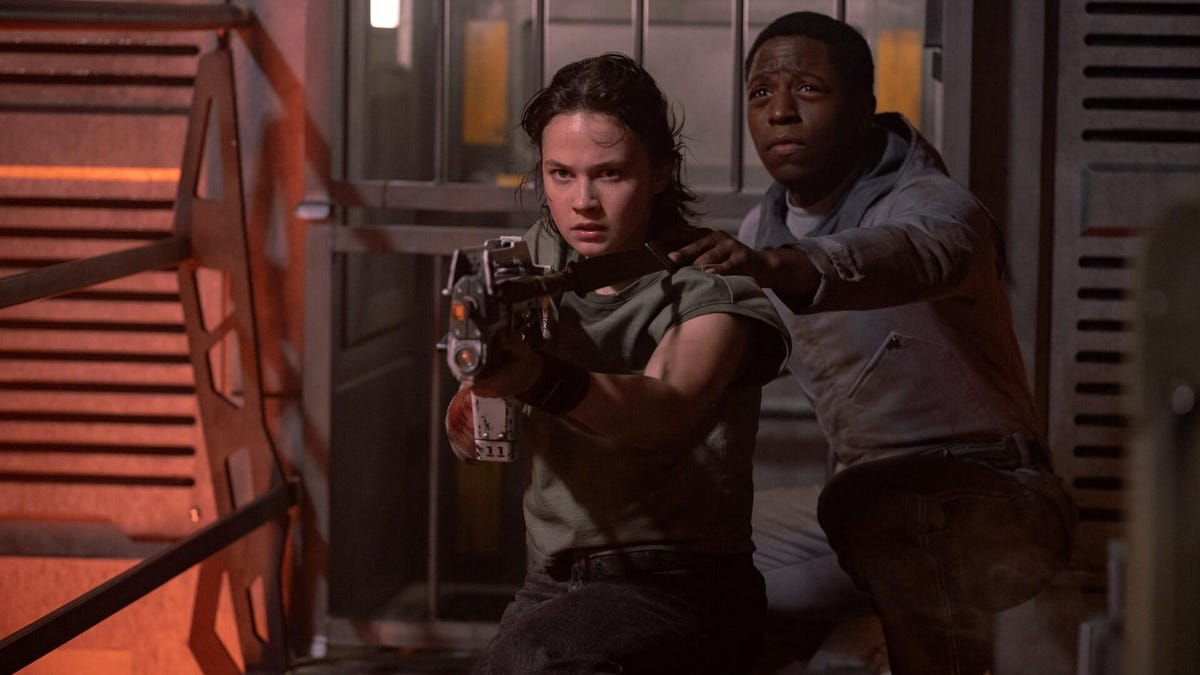‘Alien: Romulus’ Review: A Worthy Sci-Fi Sequel That Makes Space Scary Again




Directed by horror director Fede Álvarez (Evil Dead, Don’t Breathe), Alien: Romulus hits theaters Friday, August 16. The film follows a group of young space colonists who embark on a mission and encounter a horde of terrifying creatures they’ve never seen before.
Set between the events of Ridley Scott’s 1979 original Alien and James Cameron’s action-packed sequel Aliens, the new film successfully carves out a place for itself in the acclaimed franchise. Alien: Romulus is a worthy homage to its predecessors, delivering the terrifying goods and finally bringing monster horror back to space.
Civil War star Cailee Spaeny leads the Romulus cast as Rain, a young woman on a mission to start a new life on a distant planet, far from the Weyland-Yutani mining colony she calls home. Andy, a synthetic played by Industry’s David Jonsson, is her family, friend and protector. Isabella Merced, Aileen Wu, Archie Renaux and Spike Fearn round out the tight-knit ensemble.
Read more: Where to Stream Every ‘Alien’ Movie Before ‘Alien: Romulus’
Alien: Romulus delivers an original, standalone story that takes audiences back to the franchise’s roots. The jump scares are plentiful, the scenery is brutal, the performances are solid, and the xenomorphs are back on screen doing what they do best: hunting down Weyland-Yutani workers and tearing them apart.
Before I continue with the review, I want to let you know the following: spoiler warning. If you scroll past this point, you may be exposed to an army of face-hugging spoilers. If you haven’t seen Alien: Romulus yet and want to avoid further story details, turn back now.

Alien: Romulus is easily the third best film in the series. The cast performances, particularly those of Spaeny and Jonsson, establish and sustain the emotional stakes. Spaeny proves himself a dominant protagonist, filling the Ripley void left by Sigourney Weaver with grit and tenacity. Jonsson delivers a range of emotional nuances as Rain’s synth companion, Andy.
Álvarez limited the scope of the story, resulting in a tight-knit fight for survival that runs at full tilt. That’s one of the few narrative similarities that connects this episode to Scott’s groundbreaking original.
Both films begin at a slow pace, allowing the character development and world-building to unfold organically. Each film features a close-knit group fighting for survival in a unique location. And the set design fully embraces the overtly erotic influence of Swiss artist HR Giger.
Giger’s biomechanical designs have influenced the Alien universe for nearly five decades, but Romulus does something most entries have largely avoided: it leans heavily into the provocative nature of its art. More than once, I found myself uncomfortable with the images on screen. Gruesome (and gooey) kills soon followed.

The xenomorph reveals itself in Alien: Romulus.
Álvarez loves practical effects in horror films. With Alien: Romulus , the director enlisted the original Stan Winston special effects crew from Aliens to return to the world they helped create. They worked their creative magic here, bringing the xenomorphs and face-huggers to life through animatronics and puppetry.
“I’m obsessed with the lack of green screens, so we built every creature and every set ourselves,” Álvarez said. told The Hollywood Reporter. “Everything had to be built, so we really lived and breathed in these spaces.”
This attention to detail gives Alien: Romulus a tangible, claustrophobic feel that the franchise has been lacking for decades. The sound design and use of silence as a narrative device allow the film to breathe where it needs to, recalling the original film’s tagline: “In space, no one can hear you scream.”
Alien: Romulus is a standalone entry in the series, much like Rogue One was for Star Wars’ Skywalker Saga. That said, Romulus does tie into the events and characters of the first two Alien films and Prometheus — surprisingly enough.
Romulus takes place before Aliens , but the sequel’s influence here is aesthetic. Once the film’s second half begins, Romulus shifts gears and ramps up the action to a whole new level. If there’s one thing every Alien fan wants, it’s a hero who can take down these fang-like creatures with a pulse rifle. Álvarez knows this because he’s a fan — so he delivers exactly what fans want.

Caily Spaeny plays Rain and David Jonsson is Andy in Alien: Romulus.
There are a few rules and boundaries that have long been established within the Alien canon regarding how the xenomorphs and face-huggers operate. Romulus is a fun thrill ride that takes place in this familiar sandbox and takes the story to some unexpected places.
The face-huggers get an epic amount of screen time, allowing the creatures to spring to spider-like life in new and unnerving ways. A zero-gravity sequence featuring the aliens’ acidic blood provides a deliciously jarring perspective on the monster’s biological self-defense mechanism that had me on the edge of my seat. A wildly creative turn in the third act introduces a new threat into the mix that’s sure to generate plenty of passionate debate.
Despite all my praise and love for this film, I would be remiss if I didn’t mention its negatives.
While the film makes fun use of practical effects, CGI is used here. However, the quality of the computer-generated images is substandard and distracting when they appear on screen.
The purpose of each scene is to advance the story. Romulus falls into the common trap of telegraphing his intentions. A little cinematic finesse could have smoothed over these plot threads. The last thing I want is for characters to make stupid choices to set off a major plot point. Unfortunately, this happens a few times.
Criticisms aside, Alien: Romulus is a blast. It brings back the terrifying glory to the universe that Ridley Scott built. Álvarez has made the Alien movie that fans have been craving. It rips and it roars. The franchise is in good hands now. I can’t wait to see what happens next.




